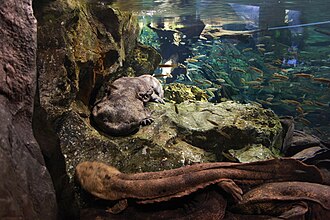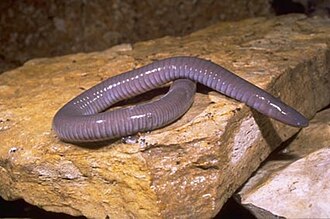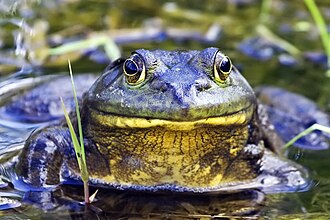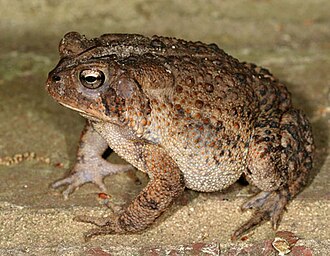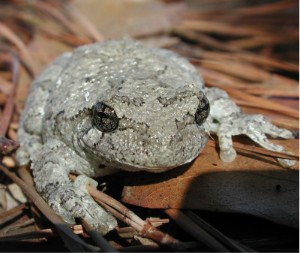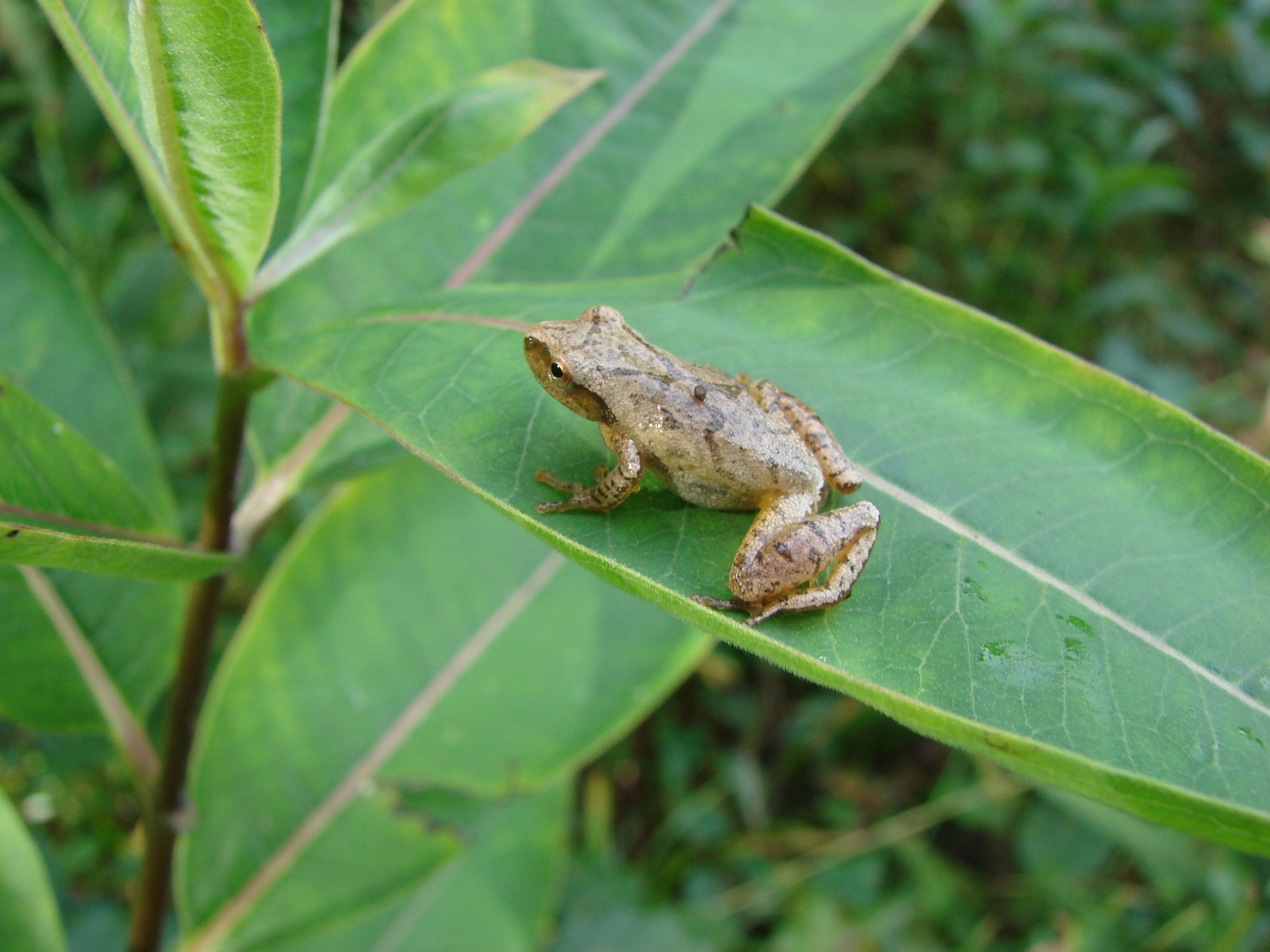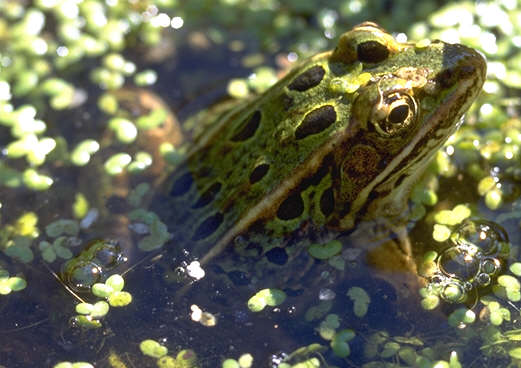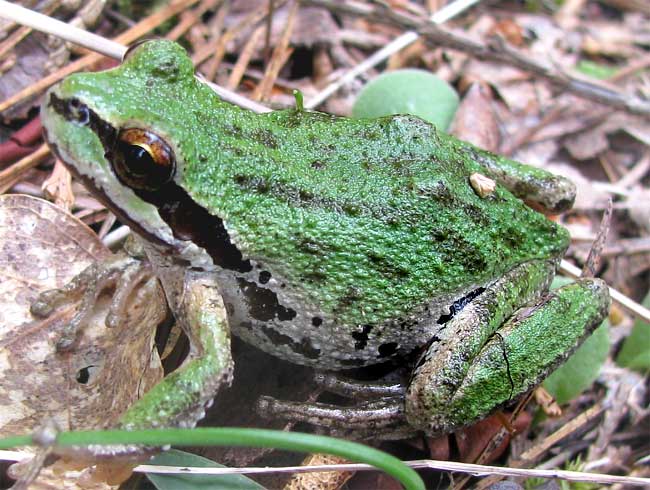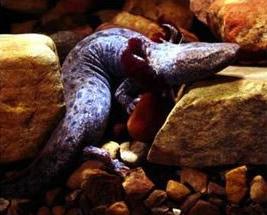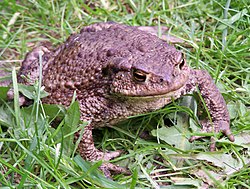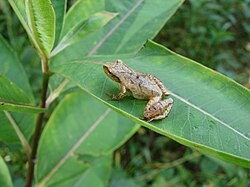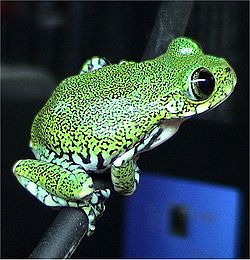Difference between revisions of "AY Honors/Amphibians/Answer Key/es"
(Created page with "{{Species id/es | latin_name = Lithobates catesbeianus | common_name = Rana toro | image = Bullfrog - natures pics.jpg | range = La rana toro es nativa de norteamérica. Se en...") |
(Created page with "{{Species id/es | latin_name = Bufo americanus | common_name = Sapo americano | image = Bufo americanusPCCA20060417-3352B.jpg | range = El sapo americano es una especie común...") |
||
| Line 85: | Line 85: | ||
}} | }} | ||
| − | {{Species id | + | {{Species id/es |
| latin_name = Bufo americanus | | latin_name = Bufo americanus | ||
| − | | common_name = | + | | common_name = Sapo americano |
| image = Bufo americanusPCCA20060417-3352B.jpg | | image = Bufo americanusPCCA20060417-3352B.jpg | ||
| − | | range = | + | | range = El sapo americano es una especie común que se encuentra en todo el este de los Estados Unidos y de Canadá. |
| − | |description = | + | |description = El sapo americano es de tamaño mediano que normalmente se encuentra en el rango de 5 a más de 8.5 cm. El color y el patrón varían. El sapo americano en el este tiene manchas que contienen una a dos verrugas. También tiene verrugas más grandes en la tibia o inferior de la pierna debajo de la rodilla. Aunque el vientre usualmente tiene manchas, en general es más en el medio hacia adelante (en algunos individuos raros puede haber pocas o sin manchas). |
}} | }} | ||
Revision as of 17:54, 16 February 2021
| Anfibios | ||
|---|---|---|
| Asociación General
|
Destreza: 1 Año de introducción: 1945 |
|
Requisitos
|
La especialidad de Anfibios es un componente de la Maestría Naturaleza. |
|
La especialidad de Anfibios es un componente de la Maestría Zoología. |
| Conexión Logros para la Investidura: Esta especialidad está relacionada con los requisitos de Logros para la Investidura para AMIGO Estudio de la naturaleza que requiere (como una de dos opciones) mantener y observar un pequeño anfibio/reptil en un terrario. como está escrito en el requisito 11b de esta especialidad. Esta especialidad es una elección popular para la especialidad de la categoría de Naturaleza de nivel de destreza 1 requerido para los AMIGOS. |
1
Anfibios viven la mitad de su vida en el agua y la otra mitad en la tierra. Son vertebrados de sangre fría. Los anfibios son capaces de respirar a través de su piel, haciendo que sean muy sensibles a cualquier cosa que toquen, incluyendo la mano del hombre. Al observar los anfibios, uno nunca debe tocarlos. Los anfibios tienen dedos en los pies en lugar de garras.
2
- Orden Anura (ranas y sapos)
- Las ranas adultas y los sapos adultos se caracterizan por sus largas piernas traseras, un cuerpo corto, dígitos reticulados, los ojos que resaltan y la ausencia de una cola. La mayoría tienen un estilo de vida semi-acuática, pero se mueven fácilmente por tierra saltando o brincando. Por lo general ponen sus huevos en charcos, estanques o lagos; y sus larvas, llamadas renacuajos, tienen branquias y se desarrollan en el agua.
- Orden Caudata (tritones y salamandras)
- Los cuadata tienen cuerpos delgados, las piernas cortas y colas largas. La piel húmeda de los anfibios hace que vivan en hábitats cerca del agua o bajo alguna clase de protección en suelo húmedo, usualmente en un bosque. Algunas especies son acuáticas durante toda la vida, algunas están en el agua de forma intermitente y algunas son totalmente terrestres como adultos. Salamandras superficialmente se parecen como las lagartijas pero se distinguen fácilmente por su falta de escalas. Ellos son capaces de regenerar extremidades perdidas.
3
El uso del nombre común «rana» y «sapo» no tiene ninguna justificación taxonómica. Desde un punto de vista taxonómico, todos los miembros de la orden Anura son ranas, pero sólo se consideran miembros de la familia Bufonidae como «sapos verdaderos». El uso del término «rana» en los nombres comunes generalmente se refiere a especies que son acuáticas o semi-acuáticas con las pieles lisas o húmedas; y el término «sapo» generalmente se refiere a las especies que tienden a ser terrestre con la piel verrugosa y seca. Una excepción es el sapo de vientre de fuego (Bombina bombina): mientras que su piel es levemente verrugosa, prefiere un hábitat acuático.
4
La primera línea de defensa para los anfibios es no ser visto por un depredador. El pequeño tamaño y la coloración de muchas especies ayudan en este sentido. A veces, en lugar de camuflarse, las ranas son de colores muy brillantes. La coloración en este caso sirve como una advertencia porque estas ranas son venenosas.
Muchas ranas contienen toxinas leves que las hacen desagradables a los depredadores. Por ejemplo, todos los sapos tienen grandes glándulas venenosas, las glándulas parótidas, ubicadas detrás de los ojos en la parte superior de la cabeza. Algunas ranas, como las ranas venenosas de dardo, son especialmente tóxicas.
Las salamandras tienen la capacidad de separar sus colas cuando quieran. Cuando un depredador capta una salamandra por la cola, la salamandra separa su cola y se escapa. La cola se regenera o vuelve a crecer.
5
Con una búsqueda por Internet se puede encontrar una lista de anfibios en su área local patrocinada por el gobierno o una universidad. Alternativamente, se puede buscar una guía de campo de anfibios que se centra en su provincia, estado, país o región. Debe definir su «localidad» de la manera que mejor se adapte a la lista que encuentre.
| Cryptobranchidae (Salamandras gigantes) | |
|---|---|
|
Dónde se encuentra : Una sola especie, la salamandra gigante americana (Cryptobranchus alleganiensis) se encuentra en el este de los Estados Unidos, mientras que las especies asiáticas se encuentran tanto en China como en Japón. Son los anfibios vivos más grandes que se conocen hoy en día. La salamandra gigante del Japón (Andrias japonicus), alcanza hasta 1,44 m (4,7 pies), se alimenta de peces y crustáceos, y se sabe que vive en cautiverio durante más de 50 años. La salamandra gigante china (Andrias davidianus) puede alcanzar una longitud de 1,8 m (5,9 pies).
|
Cryptobranchidae
|
| Gymnophiona (Cecilias) | |
|---|---|
|
Dónde se encuentra : Las cecilias se encuentran en las regiones tropicales húmedas del sudeste de Asia, India y Sri Lanka, partes de África oriental y occidental, las islas Seychelles en el Océano Índico y en el norte y el este de Sudamérica.
Descripción: Las cecilias carecen por completo las extremidadeso miembros, haciendo que las especies más pequeñas se parezcan como gusanos, mientras que las especies más grandes, con longitudes de hasta 1,5 metros, parecen serpientes. La cola es corta o inexistente. Tienen un fuerte cráneo con un hocico puntiagudo usado para forzar su camino a través del suelo o lodo. En la mayoría de las especies, el número de huesos en el cráneo se reducen y fusionan, y la boca se encuentra en la parte baja de la cabeza. Debido a su vida bajo la tierra, los ojos son pequeños y cubiertos por la piel para protegerlas, lo que ha llevado a la idea errónea de que son ciegos. Esto no es estrictamente cierto, aunque su vista se limita a la simple percepción de luz y oscuridad. Todas las cecilias poseen un par de tentáculos, situada entre los ojos y la nariz. Estos son utilizado probablemente para una segunda capacidad olfativa, además del sentido normal de olor basado en la nariz.
|
Gymnophiona
|
| Lithobates catesbeianus (Rana toro) | |
|---|---|
|
Dónde se encuentra : La rana toro es nativa de norteamérica. Se encuentra en los Estados Unidos, Canadá y México, al este de las Montañas Rocosas, pero se ha introducida en muchas otras localidades por todo el mundo. En Europa y al oeste de los EE.UU. se toman medidas para controlar su propagación, ya que compite con y saca las especies nativas.
Descripción: La rana toro es una especie grande que tiene muchas similitudes a su «especie hermana» de sapo y puede crecer hasta una longitud de 15 cm, con un peso de hasta 750 g. Las hembras son generalmente más grandes que los machos. Usualmente son distintos tonos de verde o marrón, con marrón oscuro, verde oscuro, o manchas negras y una parte inferior de color amarillo o blanco. Las ranas toro son carnívoras y consumen casi cualquier cosa que quepa en su boca que pueden dominar, incluyendo insectos, pequeños mamíferos, peces, serpientes, e incluso otras ranas. Ellas tienden a comer más a las libélulas que a las moscas. La rana adulta puede vivir hasta 13 años.
|
Lithobates catesbeianus
|
| Bufo americanus (Sapo americano) | |
|---|---|
|
Dónde se encuentra : El sapo americano es una especie común que se encuentra en todo el este de los Estados Unidos y de Canadá.
Descripción: El sapo americano es de tamaño mediano que normalmente se encuentra en el rango de 5 a más de 8.5 cm. El color y el patrón varían. El sapo americano en el este tiene manchas que contienen una a dos verrugas. También tiene verrugas más grandes en la tibia o inferior de la pierna debajo de la rodilla. Aunque el vientre usualmente tiene manchas, en general es más en el medio hacia adelante (en algunos individuos raros puede haber pocas o sin manchas).
|
Bufo americanus
|
Grey Tree Frog (Hyla versicolor)
Dónde se encuentra: Grey tree frogs inhabit a wide range, and can be found in most of the eastern half of the United States, as far west as central Texas. They also range into Canada in the provinces of Ontario and Manitoba, with an isolated population in New Brunswick.
Descripción: Grey tree frogs live primarily in trees, spending time in wooded areas, usually not far from a permanent water source. On rainy evenings they can often be found calling in or near shallow, temporary pools of water. They are nocturnal and insectivorous, consuming most any small arthropod they can catch. Mating occurs throughout the spring and summer months.
Spring Peeper (Pseudacris crucifer)
Dónde se encuentra: There are two subspecies of the spring peeper, the northern (P. c. crucifer) and the southern spring peeper (P. c. bartramiana). The northern is similar to the southern except for a strong dark marking on the southern frog's belly. The southern spring peeper is limited to northern Florida and southern Georgia, while the northern can be found all over the east of the USA and eastern Canada.
Descripción: The spring peeper is a small frog, attaining an adult size between 0.75 and 1.5 inches (up to 40mm) long. They have a dark cross on their backs roughly in the shape of an "X", though sometimes the marking may be indistinct. The color variations of the spring peeper are mostly tan, brown, olive green, or gray. Females are lighter-colored, while males are slightly smaller and usually have dark throats. Spring peepers are nocturnal frogs, so they are mostly heard but not seen. And they are especially easy to hear due to their extremely loud mating call which gives them the name "peeper".
Wood Frog (Lithobates sylvaticus)
Dónde se encuentra: Wood Frogs are found from northern Georgia and in isolated colonies in the central highlands in the eastern to central parts of Alabama, up through the northeastern United States, and all the way across Canada into Alaska. It is the most widely distributed frog in Alaska. They can be found from southeastern Alaska to north of the Brooks Range.
Descripción: Wood Frog is the common name given to Lithobates sylvaticus, previously Rana sylvatica. They are the only frogs found north of the Arctic Circle. In winter, as much as 35-45% of the frog's body may freeze, and turn to ice. Ice crystals form beneath the skin and become interspersed among the body's skeletal muscles. During the freeze the frog's breathing, blood flow, and heartbeat cease. Freezing is made possible by specialized proteins, glucose and perhaps accumulation of urea, which prevent intracellular freezing and dehydration. Wood Frogs primarily breed in ephemeral pools rather than permanent water bodies such as ponds or lakes. Adults emerge from hibernation in early spring and migrate to nearby pools. There, males chorus (a quacking sound) and mating occurs. Adult Wood Frogs spend summer months in moist woodlands, forested swamps, and bogs where they forage and maintain body moisture as surrounding environments dry out. Females' eggs are formed by late fall. By late fall or early winter, they leave forested swamps and travel to neighboring uplands to overwinter. Some may remain in moist areas to overwinter. They tend to hibernate in the upper organic layers of the soil, under leaf litter, and in close proximity to breeding pools.
Leopard Frog (Rana)
Dónde se encuentra: Once abundant in North America and Canada, their population has declined in recent years because of pollution and deforestation. Leopard frogs are often used as environmental indicator species because of their heightened sensitivity to chemical pollutants found in the air and water.
Descripción: Leopard frogs, which are also called meadow frogs and grass frogs, are a collection of so-called true frog within the genus Rana. They are commonly used as dissection specimens in biology classrooms. Leopard frogs are recognized by their green or brown coloration with distinct light-edged dark spots across the back and white underside. They also have a characteristic line of raised glandular skin extending from each eye to the groin.
Pacific Chorus Frog (Pseudacris regilla)
Dónde se encuentra: The Pacific Chorus Frog, formerly the Pacific Tree Frog (Hyla regilla) is a species of chorus frog native to the pacific coast of North America from Baja California in Mexico, through the states of California, Oregon, Washington (it is the Washington state frog), and into Canada and extreme southern Alaska. It ranges east into Nevada and Idaho.
Descripción: This is probably the most commonly heard and encountered frog in California and its call is often heard as a nighttime background sound in Hollywood movies. The Pacific tree frog can reach up to about 5 cm in length. The males are often smaller than the females. These frogs can have highly variable color on their bodies anywhere from gray, brown, tan or bright green and can even change between them. They are usually a pale or white color on their bellies. They have many variations of markings on their back and sides that are usually dark and spotty. The one identifiable mark is a dark stripe that goes over the eye from the nose to the shoulder. Their skin is covered in small bumps. They have long legs compared to their bodies and they tend to be slender. Their toes are long and are only very slightly webbed. On the end of each toe, there is a round sticky pad that is used for climbing and sticking to surfaces.
Australian Green Tree Frog (Litoria caerulea)
Dónde se encuentra: The Australian Green Tree Frog, simply Green Tree Frog in Australia, White's Tree Frog, or Dumpy Tree Frog (Litoria caerulea) is a species of tree frog native to Australia and New Guinea, with introduced populations in New Zealand and the United States.
Descripción: The Green Tree Frog can grow up to 10 centimeters (4 inches) in length. Its color depends on the temperature and color of the environment, ranging from brown to green; the ventral surface is white. The frog occasionally has small, white, irregularly shaped spots on its back, up to five millimeters in diameter, which increase in number with age.
Hellbender (Cryptobranchus alleganiensis)
Dónde se encuentra: The range of the Eastern Hellbender (C. a. alleganiensis) in North America extends from southwestern and south central New York, west to southern Illinois, and south to extreme northeastern Mississippi and the northern parts of Alabama and Georgia. A disjunct population occurs in east-central Missouri. The Ozark Hellbender (C. a. bishopi) subspecies exists as a disjunct population in southeastern Missouri and adjacent northwest Arkansas. Hellbenders are considered endangered in Illinois, Indiana, Maryland, and Ohio and rare or of "special concern" in Georgia, New York, North Carolina and Virginia.
Descripción: The Hellbender is a large aquatic salamander native to North America whose habitat includes large, swiftly flowing streams with rocky bottoms. Common names include the "snot otter" and "devil dog." Hellbenders have a flat body and head, with small eyes. Like all salamanders, they have short legs and thin bodies. Their tails, however, are especially keeled to help propel them through water. They have four toes on their front legs and five on their back ones.
Common Mudpuppy (Necturus maculosus)
Dónde se encuentra: The Common Mudpuppy is a species of aquatic salamander found throughout the northeastern United States, and parts of Canada.
Descripción: Mudpuppies prefer shallow water with lots of places to hide, but have been found at depths of up to 90 feet. The mating season is late autumn however eggs are not laid until late spring when 50 to 100 eggs are deposited in a nest cavity under a rock or other object. It takes 1 to 2 months for the eggs to hatch and 4 to 6 years for the young to reach maturity. Mudpuppies may live for up to 20 years. The common mudpuppy is nocturnal, but can be active in the day in muddy or weed-choked waters. It is carnivorous and feeds on fish, fish eggs, crayfish, insects, and molluscs.
Lesser Siren (Siren intermedia)
Dónde se encuentra: The Lesser Siren is found in the United States, primarily from Virginia to Florida, and west to Texas (ranging into northeastern Mexico as far as Vera Cruz), and north to Illinois, Indiana and Michigan.
Descripción: The Lesser Siren appears distinctly eel-like, with an elongated body, 7-26 inches (18-68 cm) in length. They have a pair of greatly reduced front legs, but no back legs. Their head is flattened and blunt with feather-like external gills on each side. They vary in color, from olive green to black, sometimes with darker colored speckling. The Lesser Siren is nocturnal, spending its days hidden in the debris and mud at the bottom of slow moving bodies of water. They feed primarily on aquatic invertebrates, including various kinds of worms, snails, and crustaceans. They will also eat the tadpoles and eggs of other amphibians.
Northern Dwarf Siren (Pseudobranchus striatus)
Dónde se encuentra: South-eastern United States
Descripción: The Northern Dwarf Sirenis a salamander lacking hind legs. It retains its gills into adulthood.
Adventist Youth Honors Answer Book/Species Account/Rhinella marina Adventist Youth Honors Answer Book/Species Account/Amietophrynus regularis
6
7
Amphibians are insect eaters, so they are very valuable for controlling mosquito populations. They are also the preferred dinner for several mammal, bird, fish, and reptile species.
Amphibians are valuable for medical research. They are raised and sold to research institutions.
The larvae of newts and salamanders are sold as fish bait.
Amphibians are closely monitored by ecologists, because they are among the first animals affected by environmental problems such as pollution and the destruction of the ozone layer.
Toxins found in toads have been successfully turned into painkillers and other drugs, including a pregnancy indicator.
8
Toads burrow below the frost line and hibernate for the winter. Plant matter actually generates a bit of heat as it decays, so toads prefer areas with plenty of leaf litter and fallen logs.
9
Here are the calls of three frogs.
| File:Bufo bufo call1.ogg | File:Pseudacris-crucifer-002.ogg | File:Leptopelis vermiculatus call.ogg |
For more frog calls, Smithsonian Folkways Recordings has several frog calls available on CD or for download. You can also search Youtube for frogs that live in your region.
10
Frogs call by passing air through the larynx in the throat. In most calling frogs, the sound is amplified by one or more vocal sacs, membranes of skin under the throat or on the corner of the mouth that bulge out during the amplification of the call.
Some frogs lack vocal sacs, but these species can still produce a loud call. Their mouths are enlarged and dome-shaped, acting as a resonance chamber that amplifies their call. The body of a guitar does much the same thing, having a large hollow section that causes the sound to resonate inside before escaping to the outside atmosphere.
11
| Tip for earning from home during the pandemic | |
| Requirement 11a is the most appropriate option. Just be careful to avoid handling or harassing the amphibians. |
- IMPORTANT
- In the 1990's, amphibian populations in the United States and Canada began a precipitous and mysterious decline. Many frogs were discovered in Minnesota with unexplained deformities, including extra limbs, missing limbs, deformed limbs, and missing eyes. As a result, many species of amphibians are now protected by state and federal laws. When observing wild amphibians, it is extremely important that they not be handled. Doing so can spread disease to these creatures, causing further decline. Before venturing out, make sure your Pathfinders understand and appreciate the danger facing amphibians today. Do not allow your group to capture or otherwise harass them, and do not destroy their environment. Rather than pursuing the two options (a and b) listed for this requirement, it may be wiser to substitute an alternate requirement. One possibility is to have your Pathfinders research the amphibian population crash.
11a
i. Dónde y cuándo se duerme
ii. Cuándo deja su hogar para alimentarse
iii. Qué tan rápido puede viajar
iv. Qué tan lejos puede saltar
y muchas otras cosas interesantes que se puede averiguar sobre él, y escribir un ensayo que cubra la información solicitada en la primera sección de esta pregunta.
It is recommended that instead of investigating wild amphibians, the student should research them using other available resources, including the Internet, books, and encyclopedias. It is recognized that observing them in the wild is by far more fascinating, but it also carries the potential to do great harm to the amphibian population. See the notes in section b for more details.
11b
Frog eggs can be purchased from http://www.nilesbio.com/subcat367.html - but only in the spring.
According to Field Guide of Amphibian Larvae and Eggs of Minnesota, Wisconsin, and Iowa, a publication of the U.S. Geological Survey (USGS), "State and federal laws protect amphibians from exploitation. Collection permits are required from the appropriate state or federal authorities before capturing, handling, or collecting amphibians."
It is therefore recommended that you not attempt to collect amphibian eggs on your own. You can download this book as a PDF from the page cited above. Even if you do not live in Minnesota, Wisconsin, or Iowa, the species covered in this book may be indigenous to your area.
The USGS publication further states, "To prevent the spread of disease to native populations, any frogs or salamanders you raise should not be released back into the environment. Lab-raised amphibians can be anesthetized and euthanized with benzocaine or tricaine methanesulfonate (MS 222, Green 2001). If you anticipate difficulty complying with this guidance, you should not undertake raising larvae in captivity."
Referencias
- Categoría: Tiene imagen de insignia
- Adventist Youth Honors Answer Book/Honors/es
- Adventist Youth Honors Answer Book/es
- Adventist Youth Honors Answer Book/Skill Level 1/es
- Categoría: Libro de respuestas de especialidades JA/Especialidades introducidas en 1945
- Adventist Youth Honors Answer Book/General Conference/es
- Adventist Youth Honors Answer Book/Nature/es
- Adventist Youth Honors Answer Book/Nature/Primary/es
- Adventist Youth Honors Answer Book/Stage 100/es
- Adventist Youth Honors Answer Book/Naturalist Master Award/Fauna/es
- Adventist Youth Honors Answer Book/Zoology Master Award/Fauna/es
- Adventist Youth Honors Answer Book/IAConnection/es
- Categoría:Especialidades JA/Identificación de especie
- AY Honors/Do at home/es
- AY Honors/Covid Tips/es


